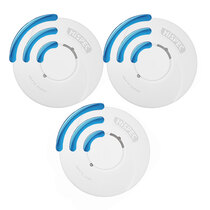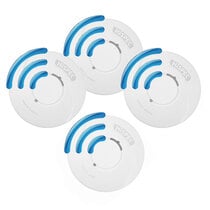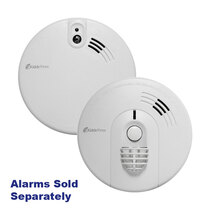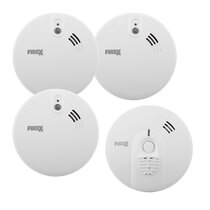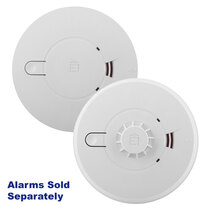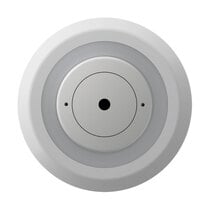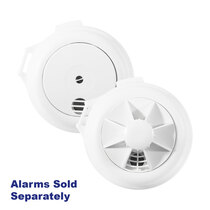-
Contact
Sales & Customer Service
0800 612 6537 support@safelincs.co.uk Live ChatDelivery Enquiries
0800 077 6149 - Resources
Fire & Safety Solutions
CALL OUR TEAM NOW 0800 612 6537
Lines open today 8am - 6pm
FREE Delivery
on marked products
Live Chat - Online
Instant help & Advice
Trade Discounts
and exclusive pricing
0% Credit Available
Open an account now
5 Star Customer Feedback
Alarms Suitable for Scottish Regulations
Comprehensive fire safety legislation transforms residential protection standards. Scottish regulations require extensive detection systems in all homes, creating some of the world's most stringent domestic fire safety requirements. Since February 2022, mandatory interlinked systems must connect smoke and heat detection throughout properties - when one alarm activates, all connected units sound, providing whole-house alerting regardless of fire location. February 2022 Implementation Mandatory interlinked systems must connect smoke and heat detection throughout properties. When one alarm activates, all connected units sound, providing whole-house alerting regardless of fire location. Owner-occupied homes share the same requirements as rental properties, making comprehensive detection universal across Scottish housing. This inclusive approach ensures consistent protection standards for all residents. Sealed battery systems meet regulatory requirements and eliminate maintenance concerns. Ten-year lithium batteries provide continuous operation without replacement needs throughout their operational lifespan. Eligibility for Free Installations Vulnerable groups may qualify for free smoke alarm provision through local fire services. Age, disability, and financial circumstances determine eligibility for publicly funded installation programmes. Application processes vary by local authority area, with most requiring online applications or telephone contact with community safety teams. Fire services prioritise high-risk households for immediate assistance. Who is eligible includes residents over 75, individuals with disabilities, and those receiving qualifying benefits. Priority systems ensure the most vulnerable receive protection first within available programme capacities. Referral pathways allow healthcare professionals, social services, and community organisations to nominate eligible households. This coordinated approach ensures comprehensive coverage for vulnerable populations. System Specifications Interlinked optical smoke alarms must be positioned in living rooms, circulation areas, and all rooms where occupants spend substantial time. Central ceiling positions provide optimal detection coverage and minimise false alarm risks. Heat alarms are required in kitchens where cooking activities would cause false activations with smoke detection. Temperature-based detection provides reliable fire protection without nuisance alarms from normal cooking. Carbon monoxide detection becomes mandatory in a room with a carbon-fuelled appliance, chimneys or attached garages. CO alarms protect against toxic gas accumulation from heating systems or vehicle exhaust. Minimum quantities depend on property layout, with larger homes requiring additional detection points. Compliance Support Our Scottish regulation packages provide complete systems designed specifically for regulatory compliance. Pre-configured solutions simplify specification while ensuring full requirements coverage. Community Programmes Fire service partnerships deliver free installation programmes for eligible residents. These community safety initiatives prioritise vulnerable households and promote fire safety awareness generally. Educational components accompany installation services, helping residents understand system operation and maintenance requirements. Knowledge transfer improves long-term system effectiveness and builds community safety awareness. Follow-up services ensure installed systems continue operating effectively through post-installation checks and user support. Ongoing engagement maintains protection levels while addressing operational questions. For eligibility information and application guidance, contact your local fire service community safety team. Professional staff can explain qualification criteria and application procedures for your area. Achieve full Scottish regulatory compliance with professional expertise. Browse our compliant system solutions and secure comprehensive protection meeting the highest domestic fire safety standards. Frequently Asked Questions (FAQs) Who is eligible for free smoke alarms in Scotland under current regulations? Eligibility for free smoke alarms in Scotland typically includes residents over 75, people with disabilities, those on qualifying benefits, and other vulnerable groups as determined by local fire services. Do all Scottish homes need interlinked smoke and heat alarms now? All Scottish homes now require interlinked smoke and heat alarms as mandatory under regulations that took effect in February 2022, applying to both owner-occupied and rental properties. How many smoke alarms are required in Scottish homes? Scottish homes require interlinked smoke alarms in living rooms and circulation spaces, plus heat alarms in kitchens and CO alarms where applicable, with exact numbers depending on property layout. Can Scottish residents install their own compliant fire alarm systems? Scottish residents can install their own compliant systems if they have appropriate technical knowledge, though professional installation is recommended to ensure proper positioning and interconnection compliance.
Read more about Scottish alarm regulations...
Radio-Interlinked 10 Year Sealed Battery Heat Alarm - UltraFire ULLH10RF
The UltraFire ULLH10RF features a sealed 10 year battery and wireless interlink with up to 15 total alarms to alert the whole house of a possible fire emergency. Ideal for kitchens, garages, basements, and lofts.
- Battery: 10 year sealed lithium battery
- Warranty: 10 year manufacturer's warranty
- Heat sensor suitable for kitchens and garages
- Wireless interlink up to 15 total alarms
Radio-Interlinked Sealed Battery Powered Smoke & Heat Alarms - Hispec RF10-PRO Range
- Battery: 10 year sealed lithium battery
- Warranty: 5 year warranty
- Radio-interlink up to 20 Hispec RF10-PRO Alarms
- Suitable for BS 5839-6: 2019 Grade F1 installations
- Compatible with the Hispec Control Unit and Carbon Monoxide Alarm
- Alarms sold separately
- Compliant with Scottish 2022 and Northern Ireland Landlord 2024 legislation
Radio-Interlinked Sealed Battery 2 Smoke and 1 Heat Alarm Kit - Hispec RF10-PRO Range
- Battery: 10 year sealed lithium battery
- Warranty: 5 year warranty
- Radio-interlink up to 20 Hispec RF10-PRO Alarms
- Suitable for BS 5839-6: 2019 Grade F1 installations
- Compatible with the Hispec Control Unit and Carbon Monoxide Alarm
- Also suitable for the 2022 Scottish legislation
Radio-Interlinked Sealed Battery 3 Smoke Alarms and 1 Heat Alarm Kit - Hispec RF10-PRO Range
- Battery: 10 year sealed lithium battery
- Warranty: 5 year warranty
- Wirelessly interlink up to 20 Hispec RF10-PRO devices
- Suitable for BS 5839-6: 2019 Grade F1 installations
- Compatible with the Hispec Control Unit and Carbon Monoxide Alarm
- Also suitable for the 2022 Scottish legislation
Mains Powered Smoke Alarms & Heat Alarms with Alkaline Back-up Battery - FireAngel W1-R Series
- Power: 230V mains powered with battery back-up
- Backup Battery: 9V alkaline battery (included)
- Warranty: 1 year warranty
- Available in Optical and Heat versions
- Interlinks with up to 12 units
- Kitemarked, CE marked and suitable for BS 5839-6: 2019 Grade D2
- Please note: alarms are sold individually
- Compliant with Scottish 2022, Welsh Landlord 2022, and Northern Ireland Landlord 2024 legislation
Mains Powered Smoke Alarms & Heat Alarms with Alkaline Back-up Battery - Kidde Firex KF Series
- 230V mains powered with alkaline back-up battery
- Available in Optical and Heat versions
- Interlink with up to 24 units
- Suitable for BS 5839-6: 2019 Grade D2 installations
- Kitemarked and CE marked
- Please note: alarms are sold individually
- Also suitable for both the Welsh and Scottish 2022 legislation
Mains Powered 2 Smoke Alarms and 1 Heat Alarm Kit with Alkaline Back-up Battery - Kidde Firex KF Series
- Power: 230V mains powered with alkaline back-up battery
- Back-up Battery: 9V alkaline battery (included)
- Warranty: 6 year warranty
- Hardwire interlink with up to 24 devices
- Suitable for BS 5839-6: 2019 Grade D2 installations
- Also suitable for both the Welsh and Scottish 2022 legislation
Mains Powered 3 Smoke Alarms and 1 Heat Alarm Kit with Alkaline Back-up Battery - Kidde Firex KF Series
- Power: 230V mains powered with alkaline back-up battery
- Back-up Battery: 9V alkaline battery (included)
- Warranty: 6 year warranty
- Hardwire interlink with up to 24 devices
- Suitable for BS 5839-6: 2019 Grade D2 installations
- Also suitable for both the Welsh and Scottish 2022 legislation
Mains Powered Smoke Alarms & Heat Alarms with Alkaline Back-up Battery - Aico Ei140e Series
- 230V mains powered with alkaline back-up battery
- Available in Optical and Heat versions (Ei146e, Ei144e)
- Made in Ireland by Ei Electronics
- Interlinks with up to 12 units
- Kitemarked, CE marked and suitable for BS 5839-6: 2019 Grade D2 installations
- Please note: Alarms are sold individually
- Also suitable for both the Welsh and Scottish 2022 legislation
Mains Powered Smoke Alarms & Heat Alarms with Self-Charging 10 Year Back-up Battery - Aico Ei3000 Series
- Available in Optical, Heat, Combined Optical & Heat, and Combined Heat & CO
- Mains powered alarms with sealed lithium back-up battery
- AudioLINK technology fitted as standard
- Interlinks with up to 12 compatible devices
- Compatible with Ei3000MRF SmartLINK Module for radio-interlinking
- Suitable for BS 5839-6: 2019 Grade D1 installations
- Also suitable for both the Welsh and Scottish 2022 legislation
10 Year Longlife Battery Digital Carbon Monoxide Alarm - Kidde 10LLDCO
- Product Lifespan: 10 years
- Battery: Built-in, lasts the life time of your product – GUARANTEED
- Warranty: 10 year warranty
- Displays CO levels from 11ppm
- Reduced sound level test feature
- Kitemarked to BS EN50291-1 (domestic use)
- Also suitable for both the Welsh and Scottish 2022 legislation
Mains Powered Carbon Monoxide Alarm with Self-Charging 10 Year Back-up Battery - Aico Ei3018
- Product Lifespan: 10 years
- Power: 230V mains powered with battery backup
- Backup Battery: Re-chargeable lithium battery
- Warranty: 5 year warranty
- AudioLINK: real time data extraction to a smart phone
- High performance electrochemical sensor
- Hardwire interlink with up to 12 compatible alarms
- Kitemarked to BS EN 50291-1: 2010
- Suitable for ceiling installation
- Also suitable for both the Welsh and Scottish 2022 legislation
LED Recessed Downlight with Smoke Alarm - Lumi-Plugin
Supplied with a mains powered smoke alarm, this Lumi-Plugin downlight blends in seamlessly with your interior whilst reducing the amount of ceiling clutter. A choice of warm or cool white lighting options is available.
- Suitable for living rooms, bedrooms and hallways
- Available with warm or cool white LED options
- Supplied with a smoke alarm to fit within the light
- Also suitable for both the Welsh and Scottish 2022 legislation
10 Year Longlife Battery Radio-Interlinked Smoke Alarms and Heat Alarms - FireAngel Pro Connected Series
- Battery operated – 10 year sealed lithium battery
- Available in Optical and Heat versions (FP2620W2-R and FP1720W2-R)
- Interlinks via radio frequency with up to 50 units
- Kitemarked, CE marked and suitable for BS 5839-6: 2019 Grade F1 installations
- Compatible with the FireAngel Pro Connected Gateway
- Please note: alarms are sold individually
- Compliant with Scottish 2022 and Northern Ireland Landlord 2024 legislation
10 Year Sealed Lithium Battery Radio-Interlinked Optical Smoke Alarms & Heat Alarms - Aico Ei600 Series
- Battery operated - 10 year sealed lithium battery
- Wireless radio-interlinked - can interlink with both mains and battery operated alarms
- 10 year sealed lithium battery
- Frequently accepted as alternative to mains powered alarms
- Suitable for BS 5839-6: 2013 Grade F1 installations
- Please note: alarms are sold individually
- Also suitable for the 2022 Scottish legislation
Mains Radio-Interlink Smoke Alarms & Heat Alarms with Sealed Longlife Back-up Battery - FireAngel Pro Connected Series
- Power: 230V mains powered with sealed longlife back-up battery
- Available in Optical and Heat versions (FP1640W2-R and FP1740W2-R)
- Interlinks via radio frequency with up to 50 units
- Kitemarked, CE marked and suitable for BS 5839-6: 2019 Grade D1 installations
- Compatible with the FireAngel Pro Connected Gateway
- Please note: alarms are sold individually
- Also suitable for the 2022 Scottish legislation
Mains Radio-Interlink Smoke Alarms & Heat Alarms with Alkaline Back-up Battery - Aico Ei140eRF Series
- 230V mains powered with alkaline back-up battery
- Available in Optical and Heat versions (Ei146eRF, Ei144eRF)
- Interlinks via radio frequency with up to 12 units
- Kitemarked, CE marked and suitable for BS 5839-6: 2019 Grade D2
- All alarms also act as repeaters
- Please note: alarms are sold individually
- Also suitable for both the Welsh and Scottish 2022 legislation
Mains Radio-Interlink Smoke Alarms & Heat Alarms with Self-Charging 10 Year Back-up Battery - Aico Ei3000RF Series
- Available in Optical, Heat and Combined Optical and Heat
- Mains powered alarms with tamper-proof lithium back-up batteries
- Suitable for BS 5839-6: 2019 Grade D1 installations
- Supplied with an Ei3000MRF SmartLINK Module for radio-interlinking
- Hybrid (wired or wireless) interlinking with up to 12 compatible devices
- Please note: alarms are sold individually
- Also suitable for both the Welsh and Scottish 2022 legislation
Mains Radio-Interlinked Combined Heat and Carbon Monoxide Alarm with Self-Charging 10 Year Back-up - Aico Ei3028RF
- Product Lifespan: 10 years
- Power: 230V mains powered with battery backup
- Backup Battery: Re-chargeable lithium battery
- Warranty: 5 year warranty
- Contains both a heat and electrochemical CO sensor
- Can interlink with up to 12 devices via SmartLINK
- Kitemarked to BS 5446-2:2003 (heat)
- Kitemarked to BS 50291-1:2010 (CO gas)
- Suitable for ceiling installation
- Also suitable for both the Welsh and Scottish 2022 legislation
Mains Powered Smoke Alarms & Heat Alarms with Alkaline Back-up Battery - Firehawk BB Series
These Firehawk mains-powered smoke and heat alarms with hardwire interlink and replaceable AAA alkaline back-up batteries are suitable for Grade D2 systems to warn all occupants of a fire.
- 230V mains power with alkaline battery backup
- 6 years manufacturer's warranty
- Hardwire interlink up to 15 Firehawk FHN smoke and heat alarms.
- Also suitable for the 2022 Scottish legislation
Page 1 (20 of 41 Products)
2022 Scottish Legislation
Alarm Power Requirements
Interlink Compatibility
2022 Scottish Legislation
Announced in February 2019 and in effect from February 2022, the Scottish Government updated legislation covering fire alarms in domestic properties. The new requirements, "Tolerable Standard Guidance: Satisfactory Fire Detection and Satisfactory Carbon Monoxide Detection", apply to all homes in Scotland and cover smoke, heat, and carbon monoxide alarms, as appropriate. A general summary of the new requirements are:
- One smoke alarm in the room most frequently used during the daytime.
- One smoke alarm in every circulation space on each storey (e.g. hallways and landings).
- One heat alarm in each kitchen.
- The smoke and heat alarms must be ceiling-mounted and interlinked.
- Where there is a carbon-fuelled appliance (e.g. boiler or gas cooker) or a flue, a carbon monoxide alarm is also required.
- All types of alarm must be mains powered (fixed wiring, not a mains plug) OR powered by a tamper-proof lifetime battery.
- All alarms must be regularly maintained and tested in accordance with the manufacturer's instructions.
For smoke and heat alarms, it can be compared to compliance with Grades D1, D2, or F1 (which can interlink) from BS 5839-6: 2019 – see our full guide to BS 5839 Part 6 for more details on types of alarm.
It is the property owner's responsibility to ensure these alarms are correctly installed and the guidance page on gov.scot outlines advice for various types of shared ownership and tenements.
Alarm Power Requirements
To comply with the updated Scottish legislation, smoke and heat alarms must be Grade D2, D1, or F1. Battery-powered Grade F1 models can only be used if they support interlinking, so care must be taken to select suitable products as most Grade F1 alarms on the market are stand-alone models. Please see the table below for more details on the Grades of alarm.
Carbon monoxide alarms do not use the same Grade distinction as smoke and heat alarms, so you must simply pay attention to the manufacturer's information regarding power source. The power requirements for carbon monoxide alarms are the same as for smoke and heat alarms: either a tamper-proof battery that lasts the full lifespan of the product, or wired into a mains circuit in the property.
Any mains-powered alarms, regardless of sensor type, must be permanently wired into a mains circuit. Alarms which use a mains plug are not suitable for the updated regulations.
Smoke & Heat Alarm Grades
British Standard 5839 Part 6 is a code of practice relating to the design, installation and maintenance of fire detection systems in domestic premises. The standard also grades fire detection systems which reflects their functionality and capability. The below table details the up-to-date grades for fire detection systems.
Alarm Grades by Power Type (BS 5839 Part 6)
| BS 5839-6: 2019 Grade | Alarm Power Type | Grade Description |
|---|---|---|
| Grade F1 | Battery Operated (Lithium) | System of one or more battery-powered smoke alarms (and heat alarms if required). The battery must be tamper-proof and last the full life of the alarm. |
| Grade F2 | Battery Operated (Alkaline) | System of one or more battery-powered smoke alarms (and heat alarms if required). The battery is user-replaceable and will not last the full life of the alarm. |
| Grade D1 | Mains Powered (Lithium Back-up) | System incorporating one or more interlinked mains-powered smoke alarms (and heat alarms if required), each with an integral stand-by supply. They can be hardwire-interlinked or radio-interlinked. The stand-by supply must be tamper-proof and last the full life of the alarm. |
| Grade D2 | Mains Powered (Alkaline Back-up) | System incorporating one or more interlinked mains-powered smoke alarms (and heat alarms if required), each with an integral stand-by supply. They can be hardwire-interlinked or radio-interlinked. The stand-by supply is user-replaceable and will not last the full life of the alarm. |
| Grade C | Mains Powered (Dedicated Circuit + Back-up) | System consisting of fire detectors and alarm sounders (which may be domestic smoke alarms) connected to a common power supply, comprising normal mains and stand-by supply, with central control equipment. |
| Grade A | Mains Powered (Panel - Built-in PSU + Back-up) | Fire detection system incorporating control and indicating equipment to BS EN 54-2, power supply to BS EN 54-4, and installed to BS 5839 Part 1, with some very minor exceptions. |
For a full summary of BS 5839 Part 6, please visit 'Fire Detection and Fire Alarm Systems for Buildings'.
Interlink Compatibility
Hardwire Interlink
Smoke alarms, heat alarms, and carbon monoxide alarms powered from a mains circuit will usually also have an interlink or interconnect terminal next to the live and neutral wire terminals. If one alarm detects a fire or CO emergency it will pass the signal to the other units which will also sound an alarm throughout the property. This is particularly important for large buildings or if the bedroom is located far away from the kitchen. Outhouses and garages can also be connected into the radio-interlinked alarm system for added peace of mind.
Mains alarms can be connected to nearby lighting circuits for power, provided the light switch does not also turn off power to the alarm, but the interlink wire must be separate and not 'piggy-back' on a mains circuit as smoke, heat, and CO alarms are not designed to take 230V in their interlink terminal. If the property does not already have mains-powered alarms wired in, or if testing one of your existing alarms does not also cause the other alarms to sound, then an electrician will need to install a new interlink cable throughout the building.
Radio-Interlink
Radio-interlinked smoke alarms, heat alarms, and carbon monoxide alarms communicate with each other via radio frequency (RF). If one alarm detects a fire or CO emergency it will pass the signal to the other units which will also sound an alarm throughout the property. This is particularly important for large buildings or if the bedroom is located far away from the kitchen. Outhouses and garages can also be connected into the radio-interlinked alarm system for added peace of mind.
Radio-interlinked alarms are sometimes referred to as wireless alarms, although this can be confusing when dealing with radio-interlinked units wired into the mains power supply in a building. Radio-interlinked alarms can be battery powered or mains powered, and we even offer battery operated smoke alarms, heat alarms, and carbon monoxide alarms with radio-interlink that contain a sealed battery which lasts the full ten years of the alarm's life.
Compatibility
Only interlink alarms with alarms from the same model range and manufacturer. Alarms from different manufacturers are not compatible and attempting to interlink them could damage the alarms. If in doubt, check the instruction manual for the alarms before purchase – we provide PDF instruction manual downloads for the majority of smoke, heat, and CO alarms on our website.
Some ranges support mixing hardwired and radio-interlink alarms in the same network, which can reduce electrician costs and disruption. All alarms on each storey would be connected together via hardwire interlink, with one alarm on each storey also being connected to each other via RF signal. This could also save money on product costs, as mains-powered alarms without radio-interlink are usually the cheapest option for interlinking alarms. Please confirm before purchase if you require this functionality.






















